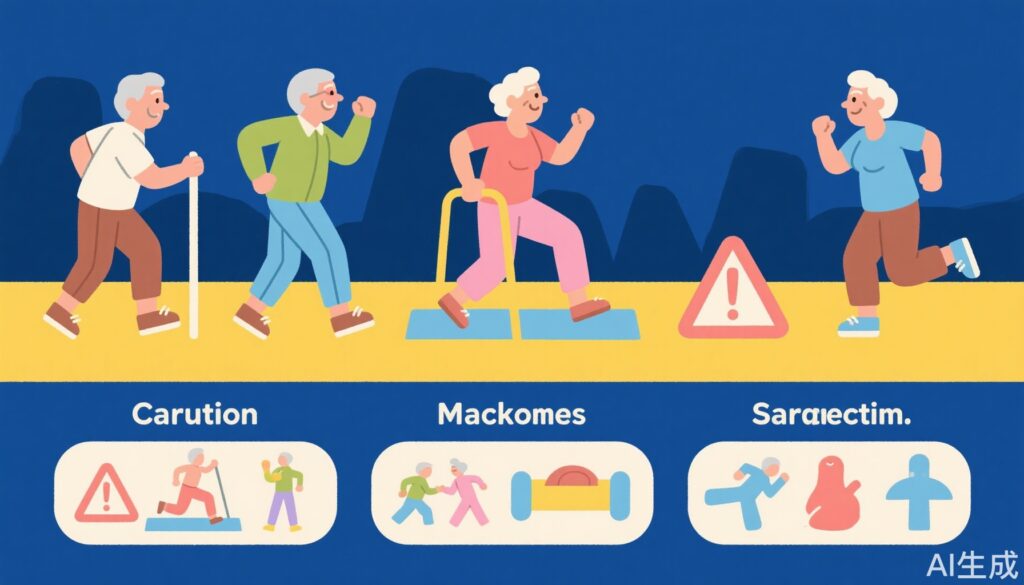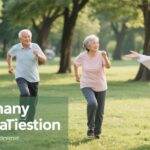Introduction
Many middle-aged and elderly individuals focus on exercise to maintain health and vitality. However, improper exercise practices can not only fail to strengthen the body but may also cause injury. Understanding common mistakes and how to avoid them is essential for safe and effective fitness in older age.
1. Excessive Duration of Square Dancing
Square dancing is a popular activity among older adults, but prolonged sessions can lead to knee pain, especially when climbing stairs. Although knee extension and flexion may feel fine during dancing, repetitive stress during stair climbing can cause discomfort or injury. Moderating the duration and intensity protects the knee joints.
2. Shoulder Pain and Shoulder Swinging Exercises
Rotator cuff tears are common among the elderly and often misdiagnosed as frozen shoulder. Repeated overhead movements such as shoulder rotations on bars, baseball pitching, and weightlifting can worsen rotator cuff injuries. Unlike frozen shoulder, which typically resolves over months, untreated rotator cuff tears can deteriorate. Exercise should avoid aggravating the shoulder joint.
3. Sit-Ups and “Swallow Flying” Exercises
Exercises like “swallow flying” can strengthen back muscles but may not suit all elderly people. Sit-ups, which require curling the legs and exerting strong abdominal force, increase lumbar spine load and accelerate disc degeneration. These exercises also cause significant head movement, posing risks for those with cardiovascular conditions due to potential blood pressure spikes.
4. High-Intensity and High-Difficulty Workouts
Some older adults believe that more intense and higher-volume exercise translates to better health benefits. However, explosive or strenuous workouts can elevate blood pressure, heart rate, and cause myocardial ischemia. Consistency and moderate intensity are more important than intensity spikes.
5. Stair Climbing and Mountain Hiking
While stair climbing is a common fitness activity, it substantially increases knee joint pressure, causing repetitive impact and potential injury. Similarly, mountain hiking, especially downhill, imposes forces 5 to 8 times body weight on the knees, exacerbating damage to the patellar cartilage and meniscus. These activities carry a high risk for knee joint damage.
6. Neck Rotation Exercises
Severe arterial sclerosis or carotid plaques in elderly individuals make vigorous neck rotations dangerous. Sudden dizziness, nausea, vomiting, or falls can occur, and in severe cases, dislodged plaques may cause strokes or other emergencies. Neck exercises should be gentle, with controlled range (under 180 degrees) and pauses to relax muscles safely.
7. Applying Heat Immediately After Sports Injuries
Ankle sprains and similar injuries are common during exercise due to uncoordinated movement or improper technique. Immediate heat application is a misconception; within the first 24 hours, cold therapy reduces tissue temperature, constricts capillaries, minimizes bleeding and swelling, and controls injury progression. After 24 hours, heat therapy promotes blood circulation, reduces swelling, and alleviates pain.
8. Walking Backwards as Exercise
Some seniors favor walking backwards, believing it enhances exercise effects. However, decline in balance, vision, and reaction times increases fall risk. Walking backwards should be avoided or done with extreme caution.
9. Exercising on an Empty Stomach in the Morning
Morning exercise without eating is dangerous for older adults, leading to insufficient brain blood supply and symptoms like dizziness, palpitations, leg weakness, and instability. Those with heart conditions risk sudden falls or cardiac events. Exercising after sunrise and after a light meal is safer and more hygienic.
10. Breath-Holding During Exercise
Reduced cardiopulmonary function in elderly people makes breath-holding exercises risky. Holding breath during exertion can cause lung alveoli rupture (pneumothorax), increase heart workload, chest tightness, palpitations, and brain hypoxia leading to dizziness or fainting. Sudden blood pressure spikes post breath-holding raise stroke risk. Activities like weightlifting, tug-of-war, or pull-ups involving breath-holding should be avoided.
Conclusion
Exercise is vital for healthy aging, but knowing how to exercise safely is equally important. Middle-aged and elderly individuals should avoid common mistakes such as excessive intensity, improper movements, and unsafe practices like breath-holding or exercising on an empty stomach. Consulting healthcare professionals for personalized exercise guidance can help maximize benefits and minimize injury risks, promoting a healthy, active lifestyle well into older age.


